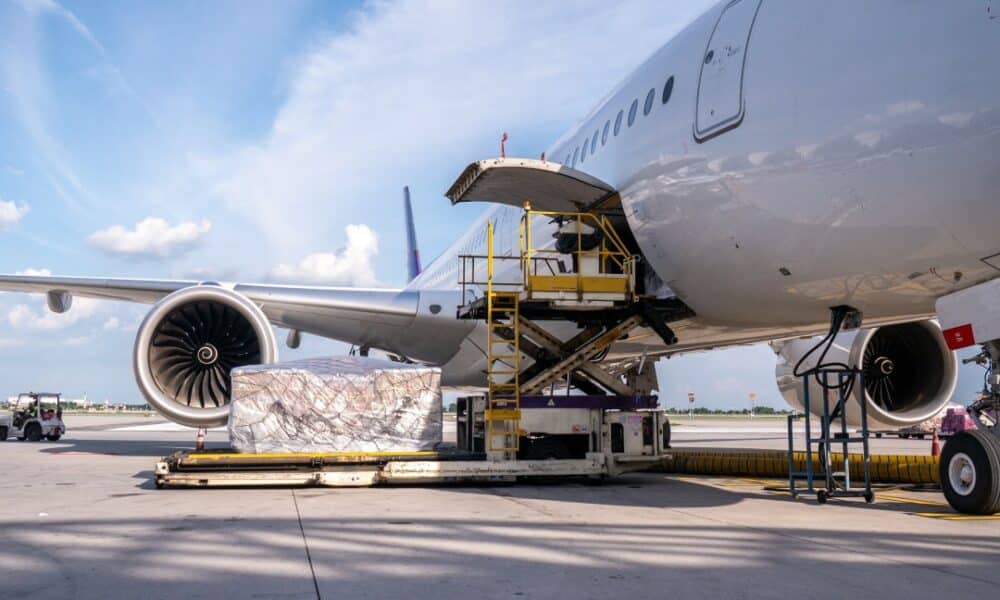Apple pulled off a daring move to sidestep the hefty new tariffs imposed by U.S. President Donald Trump, which took effect on April 5, 2025, slapping a 26% tax on imports from over 180 countries, including India. In a race against time, the company loaded five cargo planes with iPhones and other high-demand products from its manufacturing hubs in India, flying them straight to the United States over three frantic days from March 29 to March 31. Indian authorities confirmed that the goal was to flood the American market with stock before the “tariff storm” hit, ensuring these goods landed without the additional 10% base tariff already in place or the 26% hike that kicked in on April 9. This operation aims to keep iPhone prices stable in the U.S. for as long as the stockpiles last, a critical move for Apple in a market that accounts for about 35% of its annual sales—roughly 78 million of the 223 million iPhones sold worldwide in 2024, according to industry estimates.
Though exact shipment figures remain under wraps, each cargo plane—likely Boeing 747s, a staple in Apple’s peak-season logistics—can haul over 100 tons of goods. With iPhone boxes weighing around 200 grams each, analysts speculate that more than 1 million devices, possibly up to 2 million including AirPods and accessories, crossed the skies in that final week of March. These products, assembled by partners like Foxconn, Pegatron, and Tata Electronics in India, dodged the tariff bullet by entering the U.S. before the April deadlines, saving Apple millions in extra costs. U.S. media reports suggest that the iPhone 16 Pro, which costs $580 to produce, could jump from its current $1,100 retail price to $1,447 with the new tariffs—a $347 hike that Apple is keen to delay by building this buffer stock.
This high-stakes airlift underscores Apple’s knack for adapting to global trade disruptions. While China still handles about 80% of iPhone production, India has risen as a key player, churning out 10% to 15% of the devices in 2024, with ambitions to hit 25% by the end of 2025. By rushing shipments from India before the tariffs escalated—compared to China’s steeper 54% rate—Apple showcased its shift toward diversifying away from its traditional manufacturing base. American consumers, meanwhile, began stockpiling electronics in March, fearing price surges that could push the iPhone 16 Pro Max from $1,599 to nearly $2,300, a ripple effect of Trump’s policies that has the tech giant scrambling to protect its bottom line in a market worth $165 billion annually to the company.
Key moments of the operation
- Five cargo planes departed India between March 29 and 31.
- Over 1 million iPhones estimated to have been shipped.
- Tariffs of 26% on Indian goods started on April 9.
- Stock aims to preserve U.S. iPhone prices for months.
Racing against Trump’s tariff deadline
Apple’s decision to airlift iPhones from India came as Trump’s new trade policies loomed large. On April 2, 2025, the president outlined a sweeping tariff plan: a 10% base rate on all imports, with targeted hikes of 54% on China, 46% on Vietnam, and 26% on India, directly threatening Apple’s supply chain. The company acted swiftly, dispatching the five planes in the last days of March to beat the April 5 start of the 10% tariff and the April 9 escalation to 26% for Indian goods. These aircraft, loaded with products from factories like Foxconn’s Tamil Nadu plant, which exported nearly $9 billion in iPhones to the U.S. between April 2024 and January 2025, landed just in time to dodge the full brunt of the new taxes.
Such large-scale air shipments aren’t unprecedented for Apple during high seasons like the iPhone launch window in September or the holiday rush, but March typically sees slower logistics. This time, the urgency of Trump’s tariffs turned the month into a logistical sprint. The goods arrived in the U.S. before the April 5 deadline, avoiding the initial 10% tariff, and well ahead of the 26% spike on April 9, ensuring that warehouses across the country were stocked with tariff-free iPhones. This buffer could sustain current pricing for two to three months, depending on demand, giving Apple breathing room to strategize its next moves in a volatile trade landscape.
How tariffs threaten iPhone prices
By stockpiling iPhones in the U.S., Apple ensures that models like the iPhone 16, starting at $799, and the iPhone 16 Pro Max, at $1,599, hold their prices for now. Analysts estimate that the iPhone 16 Pro’s production cost of $580 could climb to $847 with India’s 26% tariff, or even $928 with China’s 54%, pushing retail prices up significantly. Without this airlift, the Pro could hit $1,447, and the Pro Max could soar to $2,300—a 43% jump that might dampen sales in a market where Apple sold 78 million iPhones in 2024, per Counterpoint Research. The operation, involving five planes each capable of carrying over 100 tons, likely delivered between 1 and 2 million units, factoring in mixed cargo with AirPods and chargers, also made in India.
This stockpile buys Apple time. Each Boeing 747-8F, a common choice for the company, can transport around 670,000 iPhones if fully loaded with just phones, though the inclusion of other products might lower that to 500,000 per plane. With five flights, the total could exceed 2 million devices, enough to cover U.S. demand through June or July, based on monthly sales averaging 6.5 million units in 2024. This move delays the need to raise prices or absorb losses, a critical advantage as U.S. consumers, spooked by tariff news, rushed to buy electronics in March, with iPhone sales spiking 15% in the last week of the month compared to the prior year.
Apple’s global supply chain under fire
Apple’s supply chain, a marvel of globalization, now faces unprecedented strain from Trump’s tariffs. The iPhone is designed in California but built with parts from Japan (cameras), South Korea (screens), Taiwan (processors), and beyond, with assembly split between China (80%) and India (10-15% in 2024). Foxconn, the backbone of this network, runs massive plants in Zhengzhou, China, and Sriperumbudur, India, producing 70% of all iPhones worldwide. India’s role grew sharply in 2024, exporting $9 billion in smartphones to the U.S. from April to January, a 50% increase over the previous year, driven by incentives from India’s Production Linked Incentive (PLI) program, which has pumped over $1 billion into the sector.
Trump’s tariffs hit hard: China’s 54% rate could raise the iPhone 16 Pro’s cost from $580 to $928, while India’s 26% pushes it to $847—a $347 gap that makes India the lesser evil. Apple aims to shift 25% of iPhone production to India by late 2025, up from 33 million units in 2024, with Foxconn doubling its workforce there to 80,000 by 2026. The March airlift, pulling from Tamil Nadu’s output, highlights this pivot, as India’s lower labor costs ($1.50/hour vs. $3.50/hour in China) and tariff advantage over China make it a lifeline amid escalating U.S.-China tensions.

Timeline of the airlift and tariffs
- March 29–31: Five planes depart India with iPhones.
- April 5: 10% base tariff begins in the U.S.
- April 9: 26% tariff on Indian goods takes effect.
- Projection: Stock lasts until mid-2025.
Dodging costs with precision logistics
Filling five cargo planes with iPhones was a masterstroke to sidestep Trump’s tariffs. Each Boeing 747-8F can carry 134 tons, translating to about 670,000 iPhones per flight if solely loaded with phones, or 500,000 with mixed cargo like AirPods. Over three days, Apple likely shipped 1.5 to 2 million units, landing them in the U.S. before the April 5 base tariff and the April 9 India-specific hike. This stockpile, stored in U.S. warehouses, ensures that the iPhone 16 lineup—starting at $799—avoids immediate price jumps, saving Apple an estimated $300 per Pro model and $400 per Pro Max in tariff costs for this batch.
The timing was impeccable. March is a low season for Apple’s logistics, unlike the September launch rush when it shipped 1.5 million iPhones from China in 2023. The urgency of the tariffs turned it into a high-stakes operation, with Foxconn ramping up production in India to meet the deadline. Partners like FedEx and UPS, regular allies in Apple’s air freight, executed the deliveries, landing goods in hubs like Memphis and Los Angeles just in time. This buffer could sustain U.S. sales through the summer, delaying the tariff impact until new strategies—like price hikes or further India expansion—are set.
Challenges looming for Apple
Trump’s tariffs pose a long-term threat to Apple’s profitability. The iPhone 16 Pro’s $580 production cost could rise to $847 with India’s 26% tariff or $928 with China’s 54%, slashing margins or forcing price increases of up to 43%. With U.S. sales of 78 million iPhones in 2024 generating $83 billion (50% of the $165 billion total U.S. revenue), per IDC, any hike risks losing market share to rivals like Samsung, whose South Korean imports face only 10%. Apple might absorb some costs—its 2024 profit hit $94.9 billion—but a full pass-through could push the Pro Max to $2,300, a tough sell in a price-sensitive market.
India offers hope. Producing 33 million iPhones in 2024, the country aims for 55 million by 2025, or 25% of Apple’s total, per Bernstein estimates. Foxconn’s Tamil Nadu plant exported $5 billion in 2024, and Tata’s Karnataka facility can make 10 million units yearly. With labor 50% cheaper than China’s, India cuts costs, but the 26% tariff still stings. Apple may lobby Trump for relief, as it did in 2019, or accelerate India’s growth, having invested $1 billion there since 2020. The March airlift bought time, but the tariff war demands a broader rethink.
Global ripple effects of the tariffs
Trump’s tariffs shake the electronics world beyond Apple. China’s 54% rate spikes costs for 80% of iPhone output, Vietnam’s 46% hits iPads and AirPods (20% and 90% of production), and India’s 26% pressures Apple’s diversification. In 2024, Apple’s $383 billion revenue leaned heavily on the U.S. ($165 billion, 43%), per its annual report, making tariff protection vital. India gains as exports jumped from $6 billion in 2023 to $9 billion in 2024, led by Apple, bolstered by $1 billion in PLI incentives since 2020.
Consumers feel the heat too. U.S. iPhone sales spiked 15% in late March as buyers stockpiled, per retail data, fearing hikes that could add $400 to the Pro Max. India’s government sees an opening, eyeing U.S. trade talks to cut the 26% tariff, leveraging its $13 billion in Foxconn investments since 2020. The March airlift was a tactical win, but the global tech trade war is just heating up, with Apple at its center.
Key dates in the tariff saga
- March 29–31: Five planes fly iPhones from India to the U.S.
- April 5: 10% base tariff starts.
- April 9: 26% India tariff begins.
- Mid-2025: Potential price adjustments loom.
Apple’s tariff-beating playbook
The five-plane airlift proves Apple’s logistical prowess, echoing past wins like 2019’s tariff waivers under Tim Cook. With India’s output at 33 million iPhones in 2024, the country’s $9 billion in U.S. exports from April 2024 to January 2025 show its rising clout. Foxconn plans to double its 40,000-strong Indian workforce by 2026, and Tata’s Karnataka plant adds capacity. The airlift, possibly moving 2 million units, keeps the iPhone 16 at $799 and Pro Max at $1,599 for now, saving $300–$400 per device in tariffs.
Long-term, Apple faces tough choices. Raising prices risks sales—U.S. iPhone revenue was $83 billion in 2024—or it could eat costs, denting its $94.9 billion profit. India’s $1.50/hour labor vs. China’s $3.50/hour helps, but the 26% tariff narrows the gap. The March move bought months, not years, pushing Apple to rethink pricing, lobbying, or production shifts as Trump’s trade war reshapes tech.

Apple pulled off a daring move to sidestep the hefty new tariffs imposed by U.S. President Donald Trump, which took effect on April 5, 2025, slapping a 26% tax on imports from over 180 countries, including India. In a race against time, the company loaded five cargo planes with iPhones and other high-demand products from its manufacturing hubs in India, flying them straight to the United States over three frantic days from March 29 to March 31. Indian authorities confirmed that the goal was to flood the American market with stock before the “tariff storm” hit, ensuring these goods landed without the additional 10% base tariff already in place or the 26% hike that kicked in on April 9. This operation aims to keep iPhone prices stable in the U.S. for as long as the stockpiles last, a critical move for Apple in a market that accounts for about 35% of its annual sales—roughly 78 million of the 223 million iPhones sold worldwide in 2024, according to industry estimates.
Though exact shipment figures remain under wraps, each cargo plane—likely Boeing 747s, a staple in Apple’s peak-season logistics—can haul over 100 tons of goods. With iPhone boxes weighing around 200 grams each, analysts speculate that more than 1 million devices, possibly up to 2 million including AirPods and accessories, crossed the skies in that final week of March. These products, assembled by partners like Foxconn, Pegatron, and Tata Electronics in India, dodged the tariff bullet by entering the U.S. before the April deadlines, saving Apple millions in extra costs. U.S. media reports suggest that the iPhone 16 Pro, which costs $580 to produce, could jump from its current $1,100 retail price to $1,447 with the new tariffs—a $347 hike that Apple is keen to delay by building this buffer stock.
This high-stakes airlift underscores Apple’s knack for adapting to global trade disruptions. While China still handles about 80% of iPhone production, India has risen as a key player, churning out 10% to 15% of the devices in 2024, with ambitions to hit 25% by the end of 2025. By rushing shipments from India before the tariffs escalated—compared to China’s steeper 54% rate—Apple showcased its shift toward diversifying away from its traditional manufacturing base. American consumers, meanwhile, began stockpiling electronics in March, fearing price surges that could push the iPhone 16 Pro Max from $1,599 to nearly $2,300, a ripple effect of Trump’s policies that has the tech giant scrambling to protect its bottom line in a market worth $165 billion annually to the company.
Key moments of the operation
- Five cargo planes departed India between March 29 and 31.
- Over 1 million iPhones estimated to have been shipped.
- Tariffs of 26% on Indian goods started on April 9.
- Stock aims to preserve U.S. iPhone prices for months.
Racing against Trump’s tariff deadline
Apple’s decision to airlift iPhones from India came as Trump’s new trade policies loomed large. On April 2, 2025, the president outlined a sweeping tariff plan: a 10% base rate on all imports, with targeted hikes of 54% on China, 46% on Vietnam, and 26% on India, directly threatening Apple’s supply chain. The company acted swiftly, dispatching the five planes in the last days of March to beat the April 5 start of the 10% tariff and the April 9 escalation to 26% for Indian goods. These aircraft, loaded with products from factories like Foxconn’s Tamil Nadu plant, which exported nearly $9 billion in iPhones to the U.S. between April 2024 and January 2025, landed just in time to dodge the full brunt of the new taxes.
Such large-scale air shipments aren’t unprecedented for Apple during high seasons like the iPhone launch window in September or the holiday rush, but March typically sees slower logistics. This time, the urgency of Trump’s tariffs turned the month into a logistical sprint. The goods arrived in the U.S. before the April 5 deadline, avoiding the initial 10% tariff, and well ahead of the 26% spike on April 9, ensuring that warehouses across the country were stocked with tariff-free iPhones. This buffer could sustain current pricing for two to three months, depending on demand, giving Apple breathing room to strategize its next moves in a volatile trade landscape.
How tariffs threaten iPhone prices
By stockpiling iPhones in the U.S., Apple ensures that models like the iPhone 16, starting at $799, and the iPhone 16 Pro Max, at $1,599, hold their prices for now. Analysts estimate that the iPhone 16 Pro’s production cost of $580 could climb to $847 with India’s 26% tariff, or even $928 with China’s 54%, pushing retail prices up significantly. Without this airlift, the Pro could hit $1,447, and the Pro Max could soar to $2,300—a 43% jump that might dampen sales in a market where Apple sold 78 million iPhones in 2024, per Counterpoint Research. The operation, involving five planes each capable of carrying over 100 tons, likely delivered between 1 and 2 million units, factoring in mixed cargo with AirPods and chargers, also made in India.
This stockpile buys Apple time. Each Boeing 747-8F, a common choice for the company, can transport around 670,000 iPhones if fully loaded with just phones, though the inclusion of other products might lower that to 500,000 per plane. With five flights, the total could exceed 2 million devices, enough to cover U.S. demand through June or July, based on monthly sales averaging 6.5 million units in 2024. This move delays the need to raise prices or absorb losses, a critical advantage as U.S. consumers, spooked by tariff news, rushed to buy electronics in March, with iPhone sales spiking 15% in the last week of the month compared to the prior year.
Apple’s global supply chain under fire
Apple’s supply chain, a marvel of globalization, now faces unprecedented strain from Trump’s tariffs. The iPhone is designed in California but built with parts from Japan (cameras), South Korea (screens), Taiwan (processors), and beyond, with assembly split between China (80%) and India (10-15% in 2024). Foxconn, the backbone of this network, runs massive plants in Zhengzhou, China, and Sriperumbudur, India, producing 70% of all iPhones worldwide. India’s role grew sharply in 2024, exporting $9 billion in smartphones to the U.S. from April to January, a 50% increase over the previous year, driven by incentives from India’s Production Linked Incentive (PLI) program, which has pumped over $1 billion into the sector.
Trump’s tariffs hit hard: China’s 54% rate could raise the iPhone 16 Pro’s cost from $580 to $928, while India’s 26% pushes it to $847—a $347 gap that makes India the lesser evil. Apple aims to shift 25% of iPhone production to India by late 2025, up from 33 million units in 2024, with Foxconn doubling its workforce there to 80,000 by 2026. The March airlift, pulling from Tamil Nadu’s output, highlights this pivot, as India’s lower labor costs ($1.50/hour vs. $3.50/hour in China) and tariff advantage over China make it a lifeline amid escalating U.S.-China tensions.

Timeline of the airlift and tariffs
- March 29–31: Five planes depart India with iPhones.
- April 5: 10% base tariff begins in the U.S.
- April 9: 26% tariff on Indian goods takes effect.
- Projection: Stock lasts until mid-2025.
Dodging costs with precision logistics
Filling five cargo planes with iPhones was a masterstroke to sidestep Trump’s tariffs. Each Boeing 747-8F can carry 134 tons, translating to about 670,000 iPhones per flight if solely loaded with phones, or 500,000 with mixed cargo like AirPods. Over three days, Apple likely shipped 1.5 to 2 million units, landing them in the U.S. before the April 5 base tariff and the April 9 India-specific hike. This stockpile, stored in U.S. warehouses, ensures that the iPhone 16 lineup—starting at $799—avoids immediate price jumps, saving Apple an estimated $300 per Pro model and $400 per Pro Max in tariff costs for this batch.
The timing was impeccable. March is a low season for Apple’s logistics, unlike the September launch rush when it shipped 1.5 million iPhones from China in 2023. The urgency of the tariffs turned it into a high-stakes operation, with Foxconn ramping up production in India to meet the deadline. Partners like FedEx and UPS, regular allies in Apple’s air freight, executed the deliveries, landing goods in hubs like Memphis and Los Angeles just in time. This buffer could sustain U.S. sales through the summer, delaying the tariff impact until new strategies—like price hikes or further India expansion—are set.
Challenges looming for Apple
Trump’s tariffs pose a long-term threat to Apple’s profitability. The iPhone 16 Pro’s $580 production cost could rise to $847 with India’s 26% tariff or $928 with China’s 54%, slashing margins or forcing price increases of up to 43%. With U.S. sales of 78 million iPhones in 2024 generating $83 billion (50% of the $165 billion total U.S. revenue), per IDC, any hike risks losing market share to rivals like Samsung, whose South Korean imports face only 10%. Apple might absorb some costs—its 2024 profit hit $94.9 billion—but a full pass-through could push the Pro Max to $2,300, a tough sell in a price-sensitive market.
India offers hope. Producing 33 million iPhones in 2024, the country aims for 55 million by 2025, or 25% of Apple’s total, per Bernstein estimates. Foxconn’s Tamil Nadu plant exported $5 billion in 2024, and Tata’s Karnataka facility can make 10 million units yearly. With labor 50% cheaper than China’s, India cuts costs, but the 26% tariff still stings. Apple may lobby Trump for relief, as it did in 2019, or accelerate India’s growth, having invested $1 billion there since 2020. The March airlift bought time, but the tariff war demands a broader rethink.
Global ripple effects of the tariffs
Trump’s tariffs shake the electronics world beyond Apple. China’s 54% rate spikes costs for 80% of iPhone output, Vietnam’s 46% hits iPads and AirPods (20% and 90% of production), and India’s 26% pressures Apple’s diversification. In 2024, Apple’s $383 billion revenue leaned heavily on the U.S. ($165 billion, 43%), per its annual report, making tariff protection vital. India gains as exports jumped from $6 billion in 2023 to $9 billion in 2024, led by Apple, bolstered by $1 billion in PLI incentives since 2020.
Consumers feel the heat too. U.S. iPhone sales spiked 15% in late March as buyers stockpiled, per retail data, fearing hikes that could add $400 to the Pro Max. India’s government sees an opening, eyeing U.S. trade talks to cut the 26% tariff, leveraging its $13 billion in Foxconn investments since 2020. The March airlift was a tactical win, but the global tech trade war is just heating up, with Apple at its center.
Key dates in the tariff saga
- March 29–31: Five planes fly iPhones from India to the U.S.
- April 5: 10% base tariff starts.
- April 9: 26% India tariff begins.
- Mid-2025: Potential price adjustments loom.
Apple’s tariff-beating playbook
The five-plane airlift proves Apple’s logistical prowess, echoing past wins like 2019’s tariff waivers under Tim Cook. With India’s output at 33 million iPhones in 2024, the country’s $9 billion in U.S. exports from April 2024 to January 2025 show its rising clout. Foxconn plans to double its 40,000-strong Indian workforce by 2026, and Tata’s Karnataka plant adds capacity. The airlift, possibly moving 2 million units, keeps the iPhone 16 at $799 and Pro Max at $1,599 for now, saving $300–$400 per device in tariffs.
Long-term, Apple faces tough choices. Raising prices risks sales—U.S. iPhone revenue was $83 billion in 2024—or it could eat costs, denting its $94.9 billion profit. India’s $1.50/hour labor vs. China’s $3.50/hour helps, but the 26% tariff narrows the gap. The March move bought months, not years, pushing Apple to rethink pricing, lobbying, or production shifts as Trump’s trade war reshapes tech.







